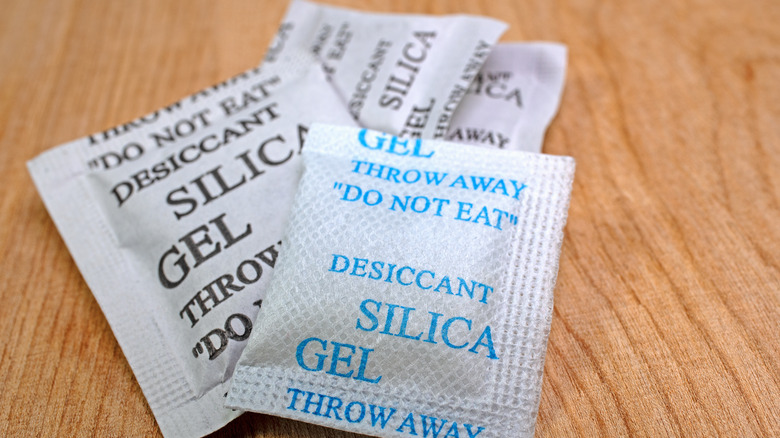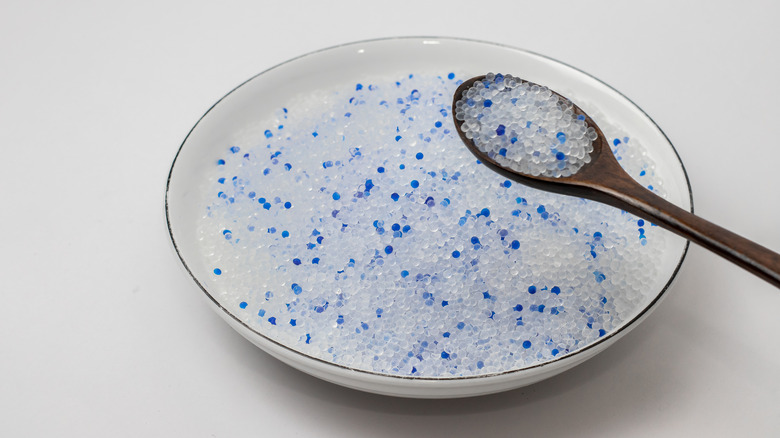Save Those Silica Gel Packets To Use In Your Bathroom. Here's Why
Often discarded with the shoeboxes from whence they came, silica gel has unknowingly given itself a pesky reputation. Carrying a warning of "DO NOT EAT," these packets are usually treated like common trash. But they're far from useless, which is why you find them in new shoes or medication bottles. Plus, believe it or not, silica gel is nontoxic. Its "do not eat" moniker is because people have choked on the entire packet, which is itself the hazard.
These packets show up in certain packages to keep whatever is inside them dry. As a drying agent, silica gel eats the moisture around it. That's why it is terrific to save them to use in a space like a bathroom, which holds a lot of moisture in the air. Like using a ventilation fan to prevent mold from entering your home, silica gel keeps moisture at bay. It can even get rid of mildew smell, too. Place little jars of packets or beads in out-of-reach places to reduce excess moisture or put them by mirrors to keep them from fogging up after a much-needed shower. Think of it as a non-electric dehumidifier.
Silica gel anti-moisture potency is so significant that a TikTok video by @biomestores went viral in 2022. As the country received heavy rainfall, folks were looking for ways to keep moisture from ruining their homes. And silica gel came to the rescue!
Why does silica work?
The qualities of silica gel as a desiccant or drying agent might seem peculiar. Yet, because it is a highly porous substance, it is adept at absorbing moisture or water. That's why silica-based kitty litter is the answer to reducing moisture in your basement too. It is a granularized silicon dioxide, hence the name. Silica does this because water molecules stick to the surface of the gel beads. In addition, silica gel can actually re-release moisture if it is kept at too high a temperature. However, that temperature is about 150 degrees Fahrenheit, so it's unlikely that will ever be an issue in your home.
These absorbent little beads can absorb up to 40% or 50% of their weight, depending on the humidity and temperature of a space. They're practically the ants of the helpful sand-like family. What makes these moisture eaters even more interesting is that even at their full absorbency capacity, they are dry to the touch.
Since you can't tell if the silica is saturated by touching it, pay attention to its appearance instead. Most silica gel you encounter is going to be non-indicating, meaning that it won't change color after saturating. Instead, you want to see how translucent it is. If it is practically see-through, chances are it is dry. You can also purchase indicating silica gel that changes color when it is fully saturated.
How to safely store silica beads
Saving silica packets from the trash is only effective if you safely store them for future use. To maintain their quality after saving them from a trash bin fate, store them in an airtight bag or container. They can be stored loose or in their packets; what is important is that they aren't exposed to moisture before you're ready to use them.
When storing the gel, loose or not, be sure to keep it away from pets and children. Although it is non-toxic, consuming the beads can still upset your stomach. Side effects of eating silica beads include nausea and vomiting.
Once you've unleashed the beads to work their magic in your bathroom, you might be worried that they'll saturate too quickly. Fear not; silica gel can actually be revitalized up to 100 times. To dry them effectively, it's recommended that you put them on a baking sheet in an oven at 250 degrees Fahrenheit for 90 minutes for every 30 ounces of silica. After cooling they are ready to be back in action.

